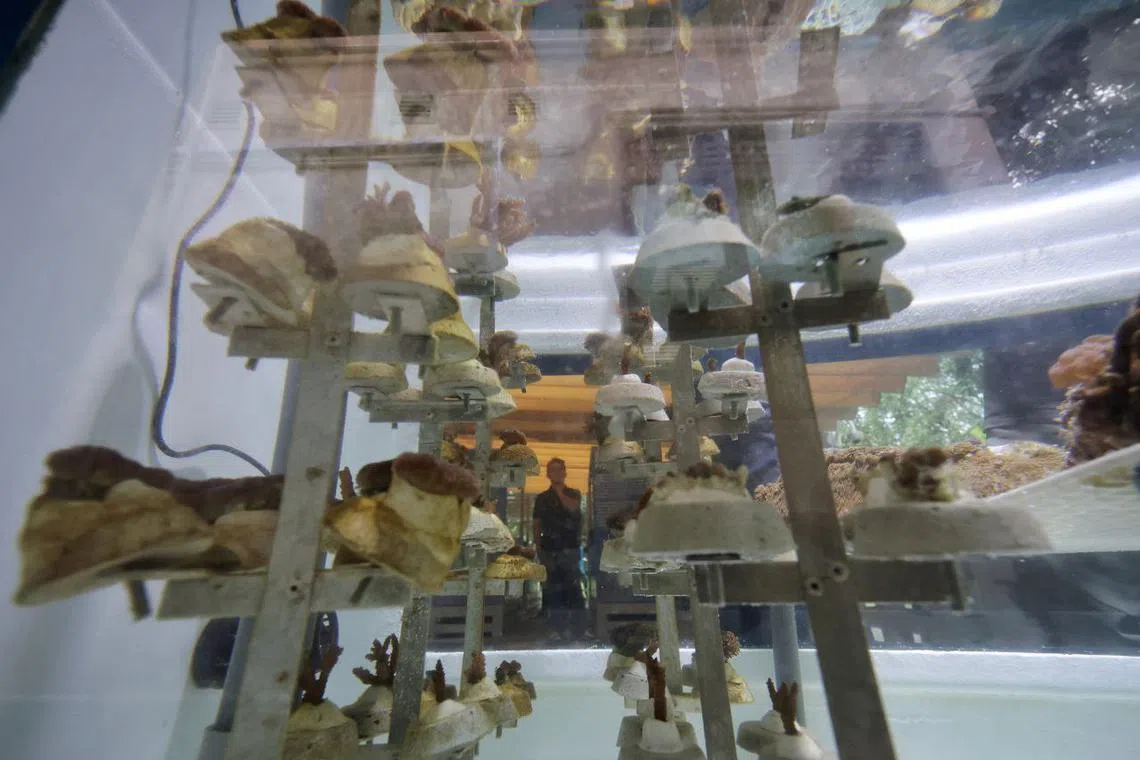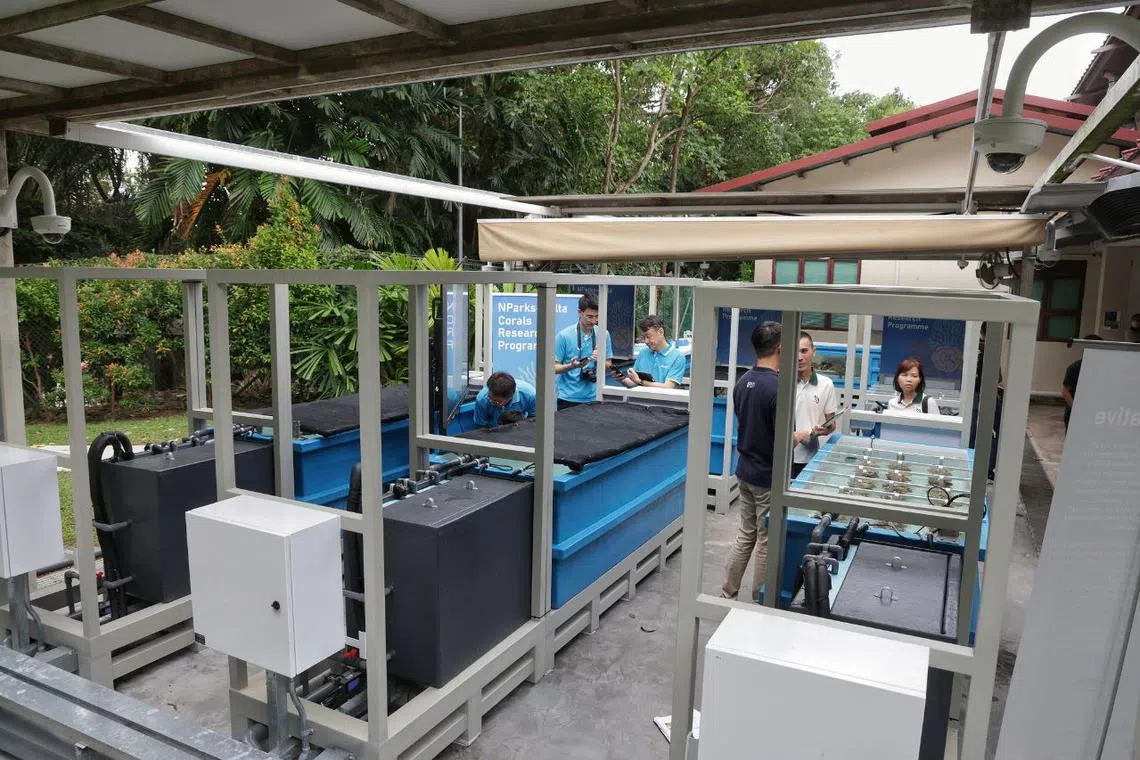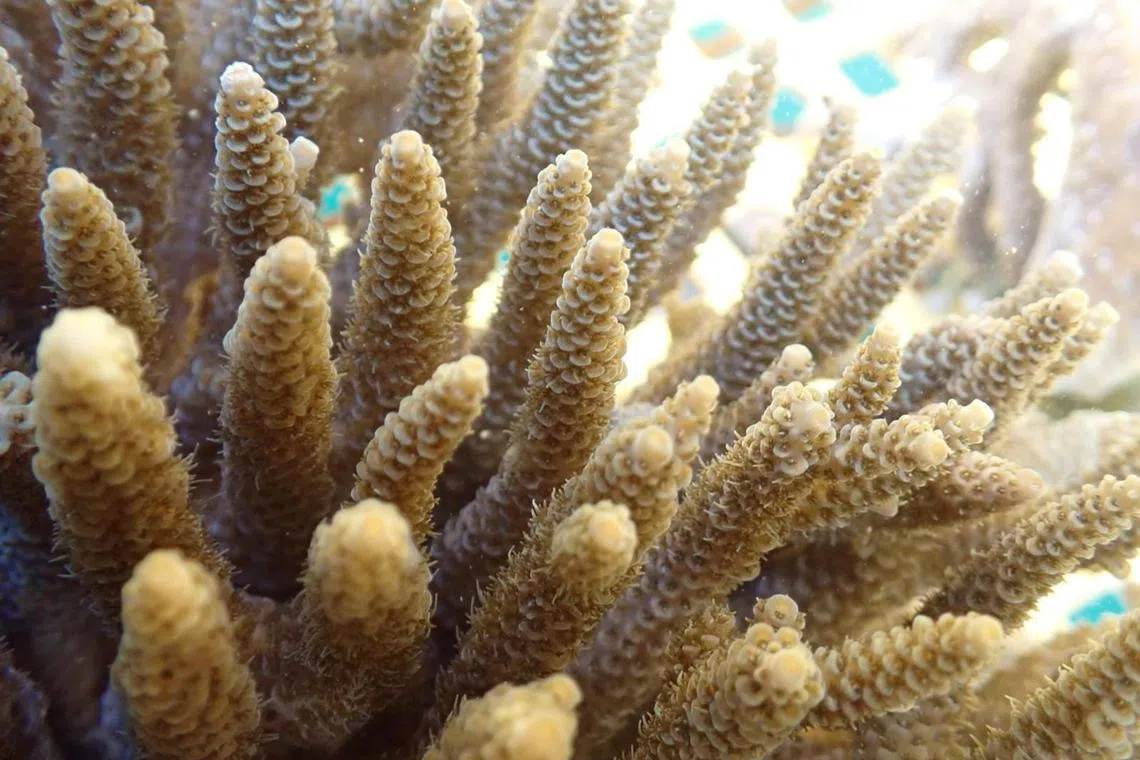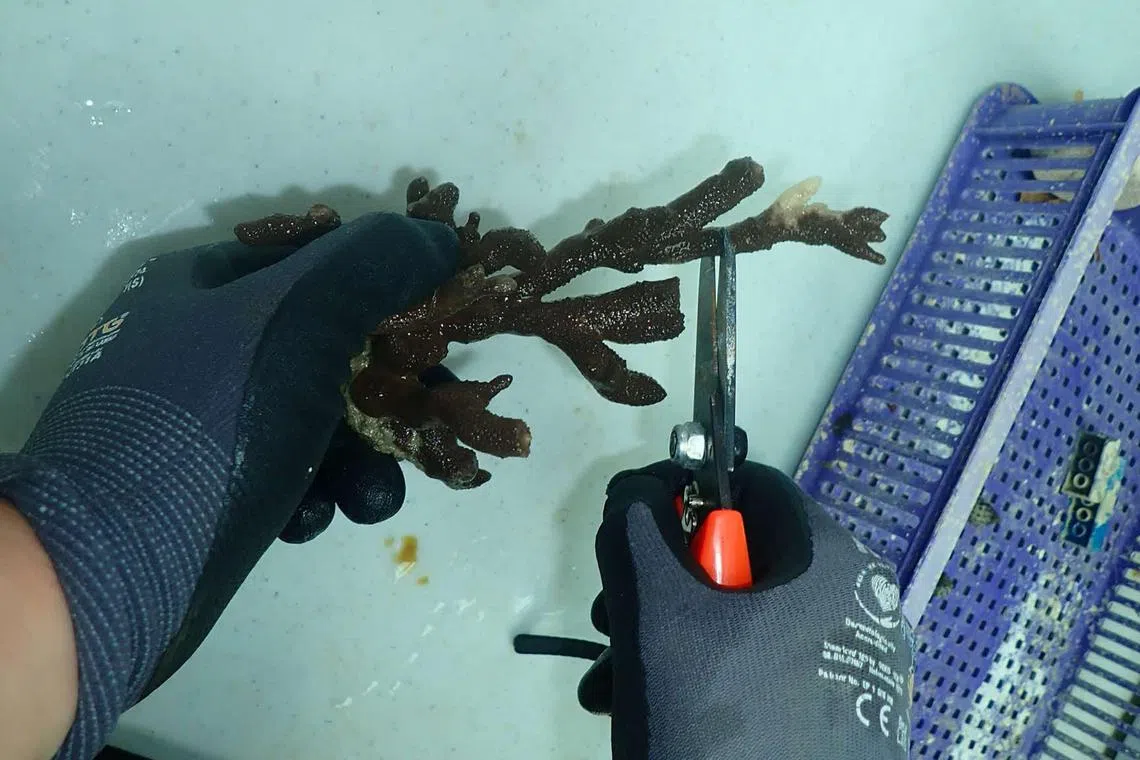Singapore’s drive to restore 100,000 corals begins with growing coral fragments in HDB-style tanks
Sign up now: Get ST's newsletters delivered to your inbox
SINGAPORE – The Republic has launched its most ambitious coral-restoration project, growing corals from fragments in “high-rise” special tanks on St John’s Island.
Once grown to a healthy size, 100,000 of these corals will be planted on degraded reefs or empty sea spaces to create new reef habitats.
The first step of this decade-long effort began at a new facility in the island’s Marine Park Outreach and Education Centre – home to six specialised tanks that can be used for large-scale coral cultivation.
The six tanks can hold up to 3,600 coral fragments, or nubbins, at any one time. To date, more than $2 million has been raised for the restoration project.
The facility is still in the works and is targeted to fully open in the second quarter of 2025. For now, there are about 600 nubbins growing in two of the tanks.
While the initial stages of the project will be helmed by researchers, marine enthusiasts will be later invited to the lab to grow corals and monitor them, said National Development Minister Desmond Lee on Dec 10, as he announced the launch of the initiative on St John’s Island.
The National Parks Board (NParks), St John’s Island National Marine Laboratory and the Friends of Marine Park community will train members of the public to cultivate corals, monitor their growth and do weeding work to remove algae from the corals, among other things.
More details on public participation will be shared when ready.
When the coral-restoration project was announced in 2023,

Once grown to a healthy size, 100,000 of these corals will be planted on degraded reefs or empty sea spaces to create new reef habitats.
ST PHOTO: KEVIN LIM
At the launch, Mr Lee was joined by world-renowned British primate expert Jane Goodall, who was on a working visit to Singapore.
Over the decades, about 60 per cent of Singapore’s coral reefs have been lost to coastal development and land reclamation. Most of its remaining intact coral reefs are found in the Southern Islands.
The Republic’s waters are home to around 250 species of hard corals, which constitute about a third of the world’s existing coral species.
The reefs here serve as habitat for more than 100 species of reef fish, about 200 species of sea sponges, and rare and endangered seahorses and clams, among other marine life.

The six tanks can hold up to 3,600 coral fragments, or nubbins, at any one time.
ST PHOTO: KEVIN LIM
Beyond boosting marine biodiversity, restoring corals will protect coastlines from waves and storms, which are expected to get stronger amid sea-level rise and climate change.
The corals to be grown in tanks and planted in the wild include several species under NParks’ species recovery programme, which protects threatened flora and fauna and helps them survive environmental change. These include the branching staghorn coral and the flat table acropora coral.
The acropora is not a common species here because it thrives in waters with strong currents and good visibility – conditions that are rarely found in Singapore.

The acropora species is not common in local waters.
photo: NParks
Coral nubbins are fragments trimmed from a colony of adult corals. However, marine biologists usually prioritise loose corals that would otherwise tumble and die when swept by waves.
Mr Lee said cultivating corals in specialised tanks is an ambitious undertaking, with conditions such as lighting and temperature as well as water quality and flow needing to be specific to each species.
To allow hundreds of coral fragments to grow in each tank, scientists at the St John’s Island National Marine Laboratory are cultivating them on vertical structures, among other methods. Coral nubbins are attached to plugs that are then affixed to a vertical frame.
The scientists and NParks staff have named these set-ups “coral HDBs”, said the minister.

Small coral nubbins are fragmented from the adult colony.
PHOTO: NPARKS
Dr Lionel Ng, a research fellow at the NUS Tropical Marine Science Institute who is involved in the coral-restoration work, noted that the survival rate of transplanted corals is about 80 per cent to 90 per cent, which is on a par with the 80 per cent survival rate of corals found in the wild here.
The tanks are paired with a smart system that will send data on water quality to researchers. This allows them to monitor tank conditions remotely and be alerted if they need to intervene.
The system is a technology of Delta Electronics, a firm that specialises in industrial and building automation solutions. Delta is also one of several donors of the more than $2 million raised so far. The other donors include GSK-EDB Trust Fund, Deutsche Bank, Takashimaya Singapore and marine fuel firm KPI OceanConnect.

A smart coral culture aquaculture system set up by Delta Electronics and installed in the culture tanks at St John’s Island’s coral culture facility on Dec 10.
ST PHOTO: KEVIN LIM
The launch of the restoration effort comes as existing corals are slowly recovering from the largest recorded global bleaching event
Announced in mid-April by the US National Oceanic and Atmospheric Administration, the global bleaching event was the fourth of its kind.
In July, areas such as St John’s, Lazarus and Kusu Islands were found to have 30 per cent to 55 per cent of coral colonies bleached and white.
With water temperatures dropping in recent months, bleached corals have started to regain colour, said Mr Lee.
NParks and NUS have been monitoring Singapore’s reefs for bleaching since July.
The findings will help identify which species are under threat and which ones are climate-resilient, and will also narrow down suitable planting sites for future coral-restoration efforts, said Mr Lee.
On whether restored corals will be able to survive future marine heatwaves, Dr Ng pointed to a research project that aims to enhance the ecological resilience of coral reefs against climate change.
“Information from that (study) will feed into this. We’ll refine our final strategies to see which species are suitable for which areas. It’s a matter of tweaking what we know of the environment and what we know of the corals to find the best match,” he added.
In her address to NParks, scientists and groups involved in the restoration project, Dr Goodall said: “We know that oceans and forests are the two great capturers of carbon dioxide (CO2) on the planet... In the oceans, we have the kelp forests and the seagrass which absorb as much CO2 as a small inland forest.
“It’s no good just protecting corals if we don’t protect kelp forests and seagrass, if we don’t protect forests and peatlands. It’s all interconnected.”


